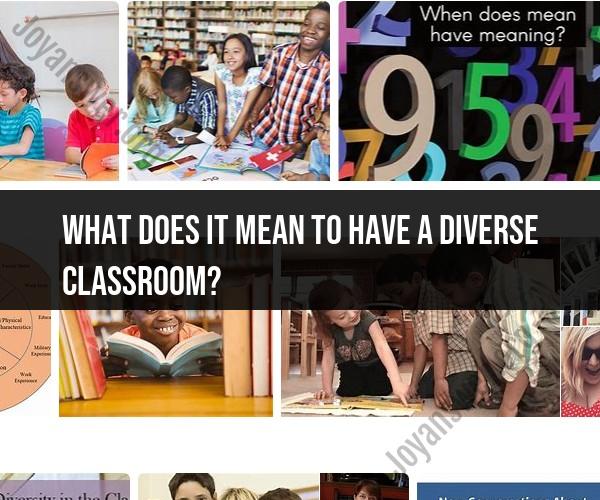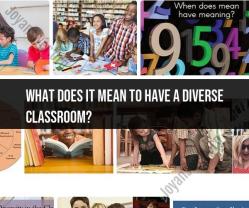What does it mean to have a diverse classroom?
Having a diverse classroom refers to the presence of students from various backgrounds, including differences in race, ethnicity, culture, religion, socioeconomic status, language, abilities, gender, sexual orientation, and more. A diverse classroom typically includes students with a wide range of experiences, identities, and perspectives.
Here are some key aspects of what it means to have a diverse classroom:
Cultural Diversity: Students in a diverse classroom may come from different cultural backgrounds, bringing with them unique customs, traditions, and beliefs. Cultural diversity enriches the classroom environment and provides opportunities for cross-cultural learning.
Racial and Ethnic Diversity: Students in a diverse classroom may belong to different racial and ethnic groups. This diversity can lead to discussions about racial and social justice, as well as opportunities for students to learn about and appreciate different cultures.
Language Diversity: Students may speak different languages or dialects at home, and English may not be the first language for all students. Language diversity can present challenges but also offers opportunities for language development and learning from multilingual peers.
Ability and Disability: Students in a diverse classroom may have varying abilities and disabilities. Inclusive education ensures that all students have equal access to learning opportunities and necessary accommodations.
Socioeconomic Diversity: Students may come from diverse socioeconomic backgrounds, which can impact their access to resources and support. Recognizing socioeconomic diversity helps educators address students' unique needs.
Gender and Gender Identity: A diverse classroom may include students who identify as male, female, non-binary, transgender, or genderqueer. Inclusive classrooms create a safe and supportive environment for all gender identities.
Sexual Orientation: Students in a diverse classroom may have different sexual orientations. Promoting inclusivity and respect for all sexual orientations helps create a welcoming atmosphere.
Religious Diversity: Students may practice different religions or belief systems. Acknowledging religious diversity fosters understanding and tolerance among students.
Learning Styles and Abilities: Students may have diverse learning styles and abilities, including giftedness or learning disabilities. Differentiated instruction and support are essential to meet individual learning needs.
Life Experiences: Students may have experienced various life events, such as immigration, refugee status, or trauma. Sensitivity to students' backgrounds and experiences is crucial for providing appropriate support.
Family Structures: Families come in various forms, including nuclear families, single-parent families, LGBTQ+ families, and more. Recognizing and respecting different family structures is important in creating an inclusive classroom.
Age Diversity: In some educational settings, such as lifelong learning programs, there may be a wide age range among students. Age diversity can bring unique perspectives and experiences to the classroom.
Fostering an inclusive and diverse classroom involves creating an environment where all students feel valued, respected, and supported regardless of their backgrounds or identities. It also involves adapting teaching methods and materials to meet the diverse needs of students and promoting cultural competence among both educators and students. Inclusive classrooms aim to celebrate differences and provide equal opportunities for all learners to thrive academically and socially.
Embracing Diversity in the Classroom: What It Signifies
Embracing diversity in the classroom means creating a learning environment where all students feel welcome, respected, and valued, regardless of their race, ethnicity, culture, religion, socioeconomic status, gender, sexual orientation, or disability.
It also means teaching students about the importance of diversity and inclusion, and helping them to develop the skills and knowledge they need to live and work in a diverse world.
Embracing diversity is important because it benefits all students. When students are exposed to different perspectives and experiences, they learn to be more open-minded and tolerant. They also develop a better understanding of the world around them.
The Impact of a Diverse Classroom on Learning and Inclusion
A diverse classroom can have a positive impact on learning and inclusion in a number of ways.
- Increased student engagement: Students are more likely to be engaged in their learning when they feel seen and heard in the classroom. A diverse classroom environment allows all students to feel comfortable contributing and sharing their ideas.
- Improved academic achievement: Students who attend diverse schools tend to perform better academically than students who attend schools with less diversity. This is likely due to the fact that diverse schools offer students more opportunities to learn from and collaborate with students from different backgrounds.
- Greater cultural awareness: A diverse classroom exposes students to different cultures and perspectives. This helps students to develop a better understanding of the world around them and to become more culturally competent.
- Increased empathy and compassion: When students learn and interact with students from different backgrounds, they develop a greater sense of empathy and compassion. This helps them to become more respectful and inclusive individuals.
Fostering Inclusivity and Celebrating Differences in Educational Settings
There are a number of things that educators can do to foster inclusivity and celebrate differences in educational settings.
- Create a welcoming and supportive classroom environment. This includes establishing clear expectations for behavior and creating a culture of respect and inclusion.
- Use inclusive language and teaching materials. This means avoiding language and materials that are biased or discriminatory.
- Teach students about diversity and inclusion. This can be done through explicit instruction, as well as through literature, art, and other cultural activities.
- Celebrate different cultures and holidays. This helps students to learn about and appreciate the diversity of their classmates.
- Provide support for students from marginalized groups. This may include providing academic support, social-emotional support, and advocacy.
By following these tips, educators can create a more inclusive and welcoming learning environment for all students.










